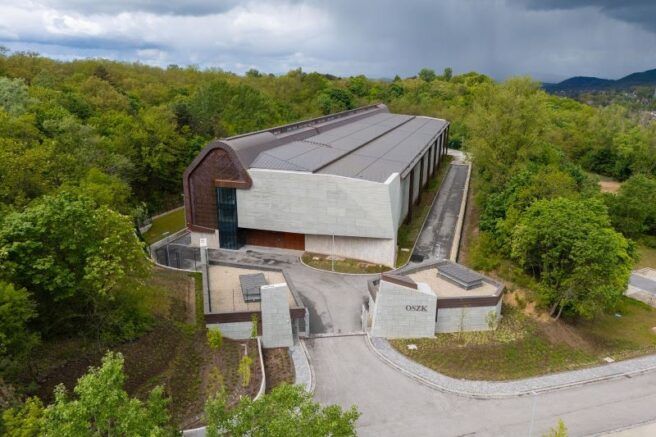On 30 July 2024 the new archival warehouse of the National Széchényi Library was officially inaugurated. The building, which is located in the city of Piliscsaba, Hungary has a gross floor area of 11 000 square metres and contains 81 000 linear metres of shelving, a server room and a restoration laboratory. The servers located here enable geo-redundancy of the digital objects of the National Library of Hungary.
The unique warehouse built for two years was designed by Attila Turi, Kossuth and Ybl Prize-winning architect. The façade of the building, which is unique not only for its function but also for its high technical quality, is inspired by the book, the mural decoration and the pattern of digital signs that symbolise the double move of the institution, symbolising the national library’s key role in the digitisation of public collections. The design of the new warehouse is in keeping with the philosophy of organic architecture, a tribute to the greatness of Imre Makovecz, an iconic figure in Hungarian organic architecture.
The plans include primarily the storage of books and periodicals received as deposit copies for preservation, as well as the long-term geo-redundant preservation of the national library’s digital objects, providing a place of enrichment for the nation’s memory for more than 50 years. The new, modern storage building meets all the requirements for preservation.
The documents delivered to the warehouse in Piliscsaba are part of the national wealth. The removal of NSZL’s archival copies (35 000 shelf metres) to the warehouse takes three years. This period poses a particular risk from the point of view of the protection of museum documents, but at the same time it provides an opportunity for the institution to carry out the cleaning and copy checking tasks of its archival stock.
Dávid Rózsa, Director General of the National Széchényi Library, emphasized in his welcome speech that “the archival storehouse of the National Széchényi Library, the great temple of national book memory, now preserves the written Hungarian cultural heritage in the silence of the Pilis mountains. Here, we can all keep safe the iron copies of the national library; the books and periodicals that come to the library as obligatory copies but are not circulated in the reading rooms. Only time can write a marginal note on their pages, and only the institution’s experts will ensure their eternal preservation.”


